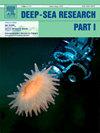几内亚比绍(西北非洲)陆架和上陆坡的软体动物组合
IF 2.1
3区 地球科学
Q2 OCEANOGRAPHY
Deep-Sea Research Part I-Oceanographic Research Papers
Pub Date : 2025-09-15
DOI:10.1016/j.dsr.2025.104592
引用次数: 0
摘要
研究了几内亚比绍海域软体动物的多样性和分布模式,以及它们与非生物因素的关系。在西班牙比绍-0810和粮农组织- cclme在大陆架和大陆斜坡区进行的三次考察期间,在20-1000米的深度范围内,使用商业底拖网收集了样本。共鉴定软体动物126种,其中腹足类86种,双壳类39种,舟壳类1种。蝶蝇科和杀蝇科是最常见的科,腹足类黄颡鱼是最常见的种。软体动物密度最大的区域为100 ~ 200 m深度,以双壳新齿蜗居多。各层的平均多样性随着深度的增加而降低,在浅水(50 m)最大。陆架、上斜坡和中斜坡三个主要组合的分离受深度、底温、沉积物类型和碳酸盐等环境因素的综合影响。本文章由计算机程序翻译,如有差异,请以英文原文为准。
Molluscan assemblages from the shelf and upper continental slope off Guinea-Bissau (north-west Africa)
The diversity and distribution patterns of molluscs in waters off Guinea-Bissau were investigated alongside their relationships with abiotic factors. Samples were collected using commercial bottom trawls during Spanish Bissau-0810 and three FAO-CCLME expeditions carried out on shelf and continental slope areas, over a depth range of 20–1000 m. A total of 126 species of mollusc were identified (86 gastropods, 39 bivalves and 1 scaphopod). Xenophoridae and Muricidae were the most frequent families, and the gastropod Ponderiana digitata was the most frequent species. Maximum mollusc density occurred between 100 and 200 m depth, with the bivalve Neopycnodonte cochlear dominating. Average diversity by strata decreased with increasing depth, with the maximum in shallow waters (<50 m). Separation of the three main assemblages (continental shelf, upper slope and middle slope) was influenced by a combination of environmental factors including depth, bottom temperature, sediment type and carbonates.
求助全文
通过发布文献求助,成功后即可免费获取论文全文。
去求助
来源期刊
CiteScore
4.60
自引率
4.20%
发文量
144
审稿时长
18.3 weeks
期刊介绍:
Deep-Sea Research Part I: Oceanographic Research Papers is devoted to the publication of the results of original scientific research, including theoretical work of evident oceanographic applicability; and the solution of instrumental or methodological problems with evidence of successful use. The journal is distinguished by its interdisciplinary nature and its breadth, covering the geological, physical, chemical and biological aspects of the ocean and its boundaries with the sea floor and the atmosphere. In addition to regular "Research Papers" and "Instruments and Methods" papers, briefer communications may be published as "Notes". Supplemental matter, such as extensive data tables or graphs and multimedia content, may be published as electronic appendices.

 求助内容:
求助内容: 应助结果提醒方式:
应助结果提醒方式:


